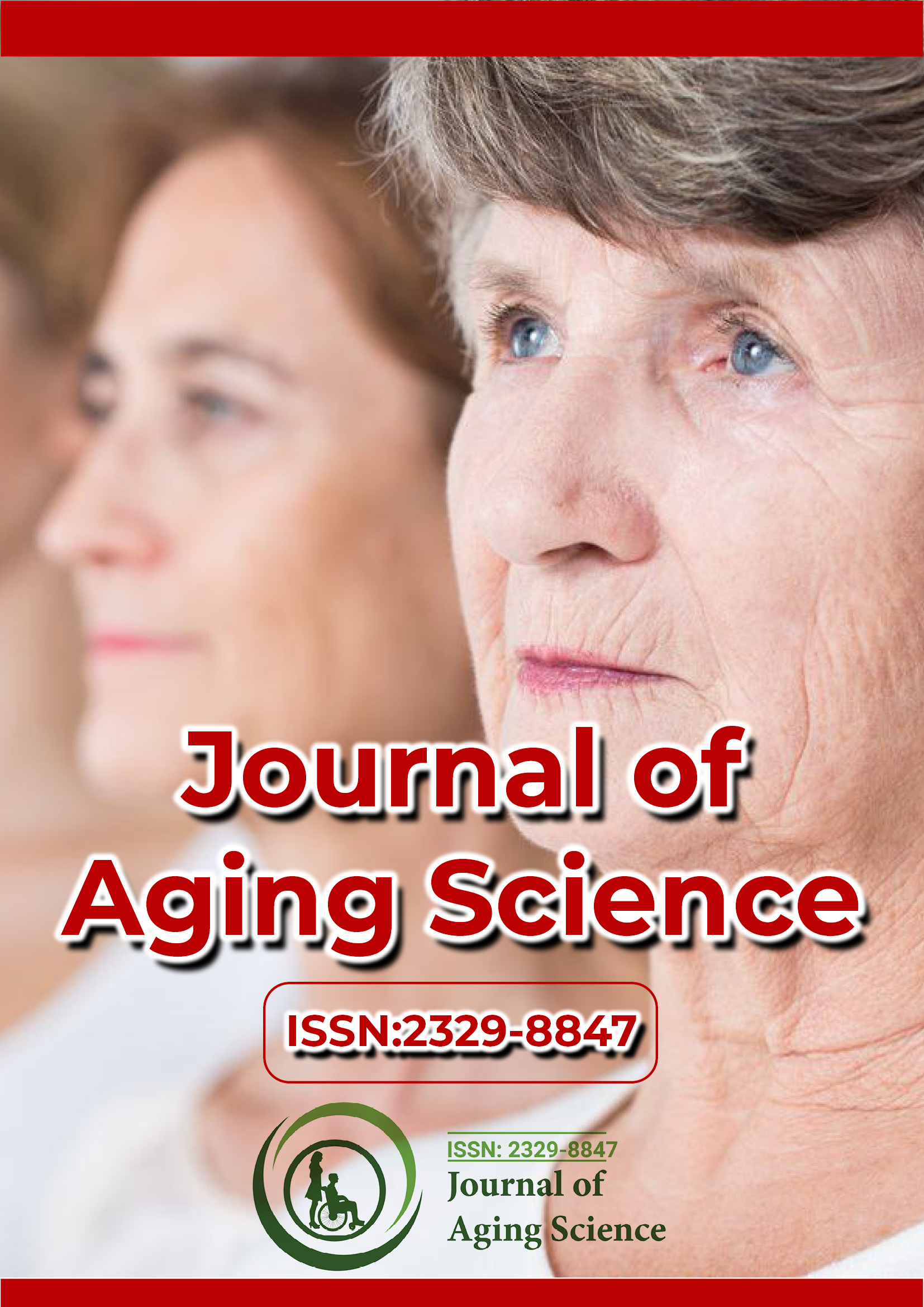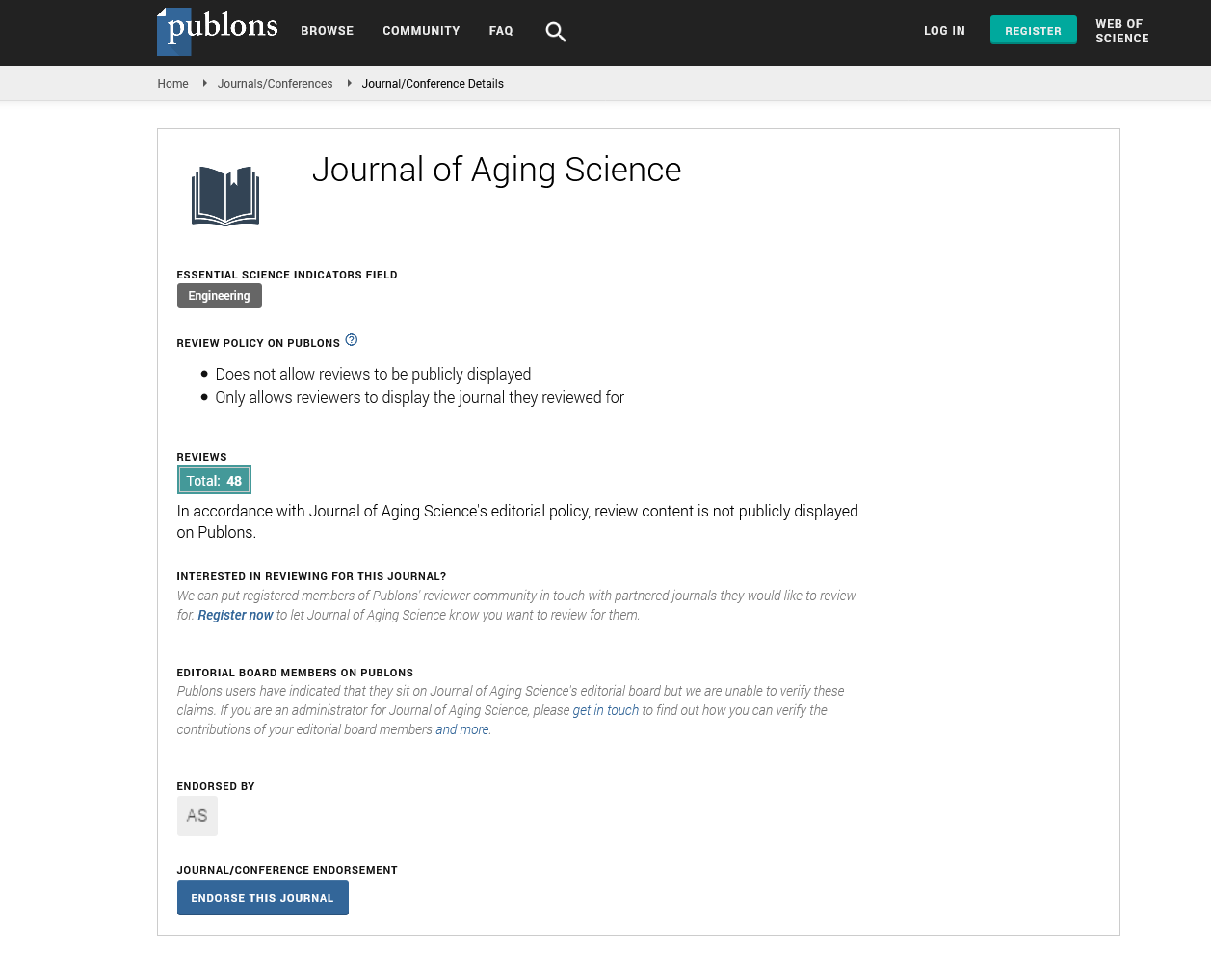Indexed In
- Open J Gate
- Academic Keys
- JournalTOCs
- ResearchBible
- RefSeek
- Hamdard University
- EBSCO A-Z
- OCLC- WorldCat
- Publons
- Geneva Foundation for Medical Education and Research
- Euro Pub
- Google Scholar
Useful Links
Share This Page
Journal Flyer

Open Access Journals
- Agri and Aquaculture
- Biochemistry
- Bioinformatics & Systems Biology
- Business & Management
- Chemistry
- Clinical Sciences
- Engineering
- Food & Nutrition
- General Science
- Genetics & Molecular Biology
- Immunology & Microbiology
- Medical Sciences
- Neuroscience & Psychology
- Nursing & Health Care
- Pharmaceutical Sciences
Short Communication - (2025) Volume 13, Issue 1
Anti-Aging Therapies: Senolytics, Gene Therapy and Pharmacological Interventions
Clayton Benayoun*Received: 27-Feb-2025, Manuscript No. JASC-25-28492; Editor assigned: 01-Mar-2025, Pre QC No. JASC-25-28492 (PQ); Reviewed: 07-Mar-2025, QC No. JASC-25-28492; Revised: 14-Mar-2025, Manuscript No. JASC-25-28492 (R); Published: 28-Mar-2025, DOI: 10.35248/2329-8847.25.13.404
Description
Aging is a complex, multifactorial process marked by a progressive decline in physiological function, contributing to the development of age-related diseases such as cardiovascular disorders, neurodegenerative diseases and cancer. As the global population ages, there has been a growing interest in understanding the biological mechanisms of aging and developing therapeutic strategies to mitigate its effects. Among the most potential methods of anti-aging therapies are senolytics, gene therapy and pharmacological interventions. These approaches aim to target the root causes of aging at the cellular and molecular levels, with the potential to extend healthy lifespan and reduce the burden of age-related diseases [1-3].
Senolytics: Clearing senescent cells
Senescence refers to a state in which cells lose their ability to divide and function normally. These cells, known as senescent cells, accumulate over time and contribute to aging and various age-related diseases. Senescent cells secrete pro-inflammatory molecules, growth factors and enzymes that create a detrimental environment known as the Senescence-Associated Secretory Phenotype (SASP). This environment promotes chronic inflammation, tissue dysfunction and an increased risk of disease [4,5].
Gene Therapy: Reversing the genetic basis of aging
Gene therapy is another innovative approach to anti-aging that involves altering the genetic makeup of an individual to prevent or treat age-related diseases. As aging is driven, in part, by genetic and epigenetic changes, gene therapy holds the potential to reverse or mitigate these changes at the molecular level. The primary goal of gene therapy in the context of aging is to restore the function of damaged or dysfunctional genes and rejuvenate cellular processes that decline with age [6].
One of the key areas of gene therapy research for aging is the study of telomeres, the protective caps at the ends of chromosomes that shorten with each cell division. Telomere shortening is a hallmark of cellular aging and is associated with the onset of age-related diseases. Telomerase is an enzyme that can extend telomeres and its activation has been proposed as a potential therapeutic strategy to delay aging. Recent studies have demonstrated that in animal models, the introduction of telomerase into cells can extend lifespan and improve tissue regeneration.
The CRISPR-Cas9 gene-editing technology also holds great potential for anti-aging therapies. CRISPR allows for precise editing of the genome and researchers are exploring ways to correct genetic mutations associated with aging and age-related diseases. By using CRISPR to repair faulty genes or enhance the expression of protective genes, it may be possible to slow down the aging process and prevent the onset of diseases such as Alzheimer’s and Parkinson’s [7,8].
Pharmacological interventions: Modulating aging pathways
Pharmacological interventions that target the molecular pathways involved in aging are another potential strategy for extending healthy lifespan. A number of drugs and compounds have been identified that can modulate key biological processes such as oxidative stress, inflammation and mitochondrial dysfunction, all of which contribute to aging and age-related diseases.
One of the well-studied classes of pharmacological interventions is the sirtuin activators. Sirtuins are a family of enzymes that regulate a wide range of cellular processes, including DNA repair, metabolism and inflammation. Sirtuin activators, such as resveratrol, a compound found in red wine, have been shown to extend lifespan in various model organisms by activating sirtuins and promoting cellular repair mechanisms. Although the effects of resveratrol on human lifespan remain unclear, its potential as a pharmacological anti-aging agent is being actively investigated [9].
Another potential pharmacological approach is the use of mTOR (mechanistic target of rapamycin) inhibitors. mTOR is a key regulator of cellular growth and metabolism and its dysregulation is implicated in aging and age-related diseases. Rapamycin, a drug that inhibits mTOR, has been shown to extend the lifespan of mice and improve healthspan by promoting autophagy, a process that helps clear damaged cells and proteins. Clinical trials are currently underway to determine whether rapamycin or similar mTOR inhibitors can have similar effects in humans [10].
Conclusion
Anti-aging therapies, including senolytics, gene therapy and pharmacological interventions, represent exciting new frontiers in the search to extend healthy human lifespan and prevent agerelated diseases. While these therapies are still in the early stages of development, the potential to mitigate the effects of aging at the cellular and molecular levels is within reach. Continued research and clinical trials will be important in determining the safety, efficacy and long-term benefits of these therapies, paving the way for a future where aging and its associated diseases can be managed or even reversed.
References
- Blagosklonny MV. Anti-aging: Senolytics or gerostatics (unconventional view). Oncotarget. 2021;12(18):1821.
[Crossref] [Google Scholar] [PubMed]
- Popescu I, Deelen J, Illario M, Adams J. Challenges in anti‐aging medicine–trends in biomarker discovery and therapeutic interventions for a healthy lifespan. J Cell Mol Med. 2023;27(18):2643-2650.
[Crossref] [Google Scholar] [PubMed]
- Lagoumtzi SM, Chondrogianni N. Senolytics and senomorphics: Natural and synthetic therapeutics in the treatment of aging and chronic diseases. Free Radic Biol Med. 2021;171:169-190.
[Crossref] [Google Scholar] [PubMed]
- Kitaeva KV, Solovyeva VV, Blatt NL, Rizvanov AA. Eternal Youth: A Comprehensive Exploration of Gene, Cellular, and Pharmacological Anti-Aging Strategies. Int J Mol Sci. 2024;25(1):643.
[Crossref] [Google Scholar] [PubMed]
- Lawrence M, Goyal A, Pathak S, Ganguly P. Cellular senescence and inflammaging in the bone: Pathways, genetics, anti-aging strategies and interventions. Int J Mol Sci. 2024;25(13):7411.
[Crossref] [Google Scholar] [PubMed]
- Melo Pereira S, Ribeiro R, Logarinho E. Approaches towards longevity: Reprogramming, senolysis, and improved mitotic competence as anti-aging therapies. Int J Mol Sci. 2019;20(4):938.
[Crossref] [Google Scholar] [PubMed]
- Zheng L, He S, Wang H, Li J, Liu Y, Liu S. Targeting cellular senescence in aging and age-related diseases: Challenges, considerations, and the emerging role of senolytic and senomorphic therapies. Aging Dis. 2024;15(6):2554.
[Crossref] [Google Scholar] [PubMed]
- Moskalev A, Guvatova Z, Lopes ID, Beckett CW, Kennedy BK, De Magalhaes JP, et al. Targeting aging mechanisms: Pharmacological perspectives. Trends Endocrinol Metab. 2022;33(4):266-280.
[Crossref] [Google Scholar] [PubMed]
- Guarente L, Sinclair DA, Kroemer G. Human trials exploring anti-aging medicines. Cell Metab. 2024;36(2):354-376.
[Crossref] [Google Scholar] [PubMed]
- Park J, Shin DW. Senotherapeutics and their molecular mechanism for improving aging. Biomol Ther. 2022;30(6):490.
[Crossref] [Google Scholar] [PubMed]
Citation: Benayoun C (2025). Anti-Aging Therapies: Senolytics, Gene Therapy and Pharmacological Interventions. J Aging Sci. 13:404.
Copyright: © 2025 Benayoun C. This is an open-access article distributed under the terms of the Creative Commons Attribution License, which permits unrestricted use, distribution and reproduction in any medium, provided the original author and source are credited.

